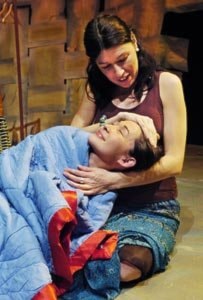Well, the set is stunning.
In fact, it’s the standout of Nakai’s co-production of Patti Flather’s Where the River Meets the Sea.
David Skelton’s set monopolized the conversation at the opening night party after Friday evening’s premiere.
It was a safe subject — a surefire way to avoid uncomfortable discussions about the production itself.
And once praise for the set started to wear thin, various partygoers were quick to latch onto Patrick Matheson’s lighting design — also great.
It’s hard to say the same of the acting and script.
Sure, the play’s premise is interesting.
A First Nations mother and her 15-year-old daughter return to Vancouver, after years in Alberta, where they moved to flee an abusive husband and father.
The mother, Lu-Anne Walker (played by Kerriann Cardinal), sets up a colourful clothing shop to sell her original designs.
Interested in rap and soccer, her daughter Jade Walker (played by Reneltta Bourque), is coping with being a teenager and with her cross-cultural upbringing.
Enter the white guy, Dayne MacFarlane (Stephen Sparks), Lu-Anne’s business course instructor and her new suitor.
A developer, he plans to build condos on the booming grounds, a bulrush-banked, mucky area where the river meets the sea.
Home to an old cannery, the booming grounds are part of the Walkers’ traditional lands.
Over morning cappuccinos and eggs Benedict, Dayne woos Lu-Anne, telling her about the spacious condo he will build her, while Jade is out talking to the seagulls and her ancestors’ spirits at the booming grounds, hashing out her emotions and her dislike for the new man in her mother’s life.
Shoes off, she dabbles along the apron of the stage, settling comfortably on a large piece of driftwood, which would take any Vancouverite home.
Then she hears them — the sound of her ancestors’ singing mixed among the waves.
Throw in estranged half-sister Katrina Mason (Jamie Lee Shebelski), who is the secret sibling Lu-Anne never told Jade about, and that’s the plot.
The sisters don’t want the land developed.
Lu-Anne wants to find love and to make Jade happy and the white developer wants it all.
By intermission the scene is set, and there are high expectations for the second act. The audience is primed for twists and turns, and further character development.
It doesn’t happen.
The dialogue, and there is lots of it, is canned. It would better suit an afternoon soap opera.
The scenes between Bourque and Shebelski are particularly painful as the discourse turns to abuse. However, the actors do their best to muddle through it.
Although Flather struggles with the dialogue, the play’s few monologues exhibit the exceptional writing she is capable of.
The script offers the potential for an intimate rapport to develop between Lu-Anne and her daughter Jade, but Cardinal’s delivery just doesn’t ring true, leaving Lu-Anne’s character flat and lifeless.
Although Bourque, who is 29, captures Jade’s teenage angst with relative ease, her emotional outbursts felt reserved and insincere.
Sparks, as the white developer and suitor, gave his character just the right amount of awkward charm, lending his big business dealings an element of humanity that could have easily been lost.
His scenes with Shebelski were engaging, because both actors gave their characters a depth that was lacking in the leads.
As the punky, tree-planting, older sister, Shebelski fit comfortably into her role, offering up a believable, strong performance that was only compromised when the dialogue became too dramatic and predictable.
Unfortunately, the whole second act fell victim to predictability.
There were no surprising twists of fate or turn of events. In fact, the plot hung in limbo right through to the curtain call.
The condo development may go ahead. Or Jade and Katrina might convince council to have it halted. Lu-Anne and Dayne could fall in love. Or they may just remain fast friends.
Walking out of the theatre, it’s not inspiration, anticipation or humanistic appreciation that is felt — it’s indecision.
That said, the closing image is strikingly beautiful.
The set, suggestive of an enormous cross-section of a woven reed basket, is backlit, and the mother’s and daughter’s shadows are cast on the weave moving to the pulse of a traditional First Nations’ song.
The woven basket set looms over the stage, like a wave, and diminishes into reeds on one side.
Combined with the sound of crashing waves and crying gulls, the set and David Deleary’s soundscape bring the audience so close to the ocean it’s almost possible to smell the salt in the air.
Costume designer Nicole Bauberger captured the characters flawlessly, dressing Katrina in combat pants and a tank top, Lu-Anne in loose flowing skirts, Jade in sporty hip-hop apparel and Dayne in kakis and dress shirts.
And her use of bright flowing fabric, to represent Lu-Anne’s original sundresses, was a nice touch.
Where the River Meets the Sea is a local co-production between Nakai and Gwaandak Theatre Adventures, featuring a Yukon playwright, a local production crew and a Whitehorse director.
The original director of the production, Vinetta Strombergs, was called away two weeks before the play opened due to unforeseen circumstances and Nakai’s artistic director Michael Clark took her place.
Flather will be workshopping a new draft of Where the River Meets the Sea in a few months. The script won the National Playwriting Competition in November, and the workshop is Flather’s prize.
Where the River Meets the Sea runs tonight through Saturday at the Yukon Arts Centre at 8 p.m. Tickets are $23 for adults (students and seniors get a discount). They’re available from Hougen’s and the arts centre box office.
Tonight there are huge discounts, even free tickets, for audience members who arrive from local women’s shelters.
And on Saturday from 5 to 7:30 p.m. there’s a woman’s clothing swap at the arts centre before the show. All are welcome — bring five articles of clothing.
